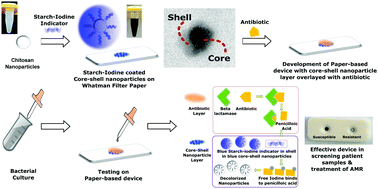Core–shell nanoparticles as platform technologies for paper based point-of-care devices to detect antimicrobial resistance
Abstract
Globally, rapid development of antibiotic resistance amongst pathogens has led to limited treatment options and high indirect costs to health management. There is a need to avoid misuse of available antibiotics and to develop rapid, affordable and accessible diagnostic technologies to detect drug resistance even in resource limited settings. This study reports the development of instrument-free point-of-care devices for detection of antibiotic resistance for rapid diagnosis of drug resistance in the penicillin, cephalosporin and carbapenem groups of antibiotics. The simple paper-based devices for flow through assay determine the presence of resistant bacteria in a sample by a visible colour change within 30 minutes. At the center of this technology is the unique sensing nanomaterial comprising of core–shell nanoparticles layered with specific antibiotics. The core is comprised of chitosan nanoparticles of size ∼15 nm coated with the starch–iodine indicator to form a shell increasing the size to ∼47 nm. The test strip is coated with the nanoparticles, air-dried and overlayed with the required antibiotic. In the presence of penicillin, cephalosporin and carbapenem resistant bacteria, the core–shell nanoparticles undergo a visible colour change from blue to white. The core–shell nanoparticles were deposited on paper to form a point-of-care device. Devices were developed to screen for three main classes of antibiotics namely penicillins, cephalosporins and carbapenems. The devices were validated using standard resistant and susceptible ATCC strains in three different sample types, pure colony, broth culture and saline suspensions. The change of colour from blue to white was considered a positive test. The time of detection was found to be 30 min, while the limit of detection was 105 cfu ml−1. The device exhibited 100% sensitivity and specificity with known resistant and susceptible cultures not only from pure colonies but also from direct samples of spiked saline suspensions with graded confounding factors of albumin, glucose, and urea. The inter-device reproducibility and storage stability of the devices was established. The developed point-of-care devices have potential as screening devices for antimicrobial resistance.

- This article is part of the themed collection: Responsive Materials for Healthcare Diagnostics


 Please wait while we load your content...
Please wait while we load your content...